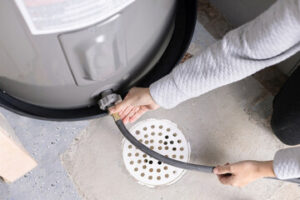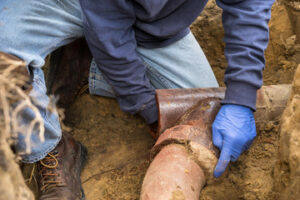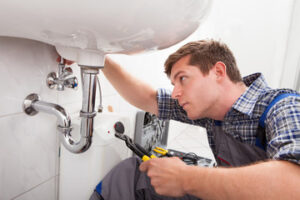Plumbing systems take away waste, provide hot and cold water, and regulate indoor climate through pipes, valves, fixtures, and appliances. Plumbers In Lexington install these systems, interpret blueprints and building codes, and perform maintenance and repairs.

Maintaining healthy drains is an important part of a plumbing system. Putting in barriers or spreading chemicals that prohibit growth can help prevent problems like blocked drains.
As they seek out water, nutrients, and warmth, tree roots are naturally drawn to sewer lines. They can cause significant blockages and damage over time if left unchecked.
While it’s impossible to completely prevent the invasive growth of tree roots into sewer pipes, you can take steps to slow down their progress. If you notice signs of a clogged or broken sewer line—like slow draining sinks and toilets, gurgling sounds, or recurrent sewer backups—it’s essential to call in a professional. They’ll use advanced inspection tools to locate the source of the problem, then provide prompt and effective solutions.
A plumbing professional will start by using a video inspection camera to explore the length of your sewer pipe and confirm the presence of root intrusions. They’ll then employ a variety of methods to cut, remove, and prevent further infiltration. They may suggest installing physical or chemical barriers to stop roots from entering vulnerable points, as well as using preventative maintenance techniques like routine sewer cleaning and annual plumbing inspections to identify potential problems.
The best way to deal with tree roots is to keep them from invading your sewer lines in the first place. To do so, avoid over-watering your soil, as excess moisture can attract roots seeking hydration. Instead, choose to water your yard with deep, infrequent doses. This encourages healthy plant life while deterring invasive root infiltration of your plumbing.
It’s also important to plant trees at a safe distance from your sewer lines, and to choose varieties with shallower root structures. Also, consider having your sewer line upgraded to a more durable material that’s less susceptible to cracking and breaking.
It’s also a good idea to have your sewer lines regularly cleaned to remove existing root buildup, as well as to remove any blockages or breakage caused by tree infiltration. You can take further preventive measures by having professional rooter services like mechanical augers or hydro jetting regularly clean your sewer pipes. These services can help reduce the need for costly repairs caused by clogged or broken sewer lines. They can also help you catch problems in their early stages, so that you can take advantage of more cost-effective intervention options.
Cast-Iron Pipes
A cast iron pipe is a pipeline used for transmitting water, gas, or sewage. Historically, these pipes were uncoated, but newer types have various coatings and linings that reduce corrosion and improve hydraulics. Like other types of pipes, they can suffer from leaks or blockages, which are often caused by corroding or trapped material. For example, a clogged pipe may result from paper towels, soap scum, grease, or hair getting into the sewer system. Fortunately, professional plumbers have several tools to inspect and repair the problem.
If a plumber discovers that your pipes are in good condition, they may recommend preventive maintenance to keep them working properly. A descaling service, for instance, can protect your pipes from corrosion and extend their lifespans. This process involves applying chemical agents that dissolve mineral buildup and wash it away safely. A thorough inspection after the procedure ensures that all scale deposits have been removed.
Another preventive solution is the insertion of an epoxy lining. This technique coats the inner surface of the pipe, creating a hard, smooth surface that protects it from cracks and rust. Plumbers can apply this solution in a trenchless fashion, minimizing the disruption to your property.
Other services that professional plumbers perform to keep your pipes in good condition include locating and fixing broken pipes, replacing damaged or mislaid pipes, and installing new drains. They can also replace outdated or clogged pipes with newer materials, such as PVC, which are more durable and require less maintenance.
In addition to preventing damage to your home, plumbing services can help you save money on energy and water bills. Leaking or damaged pipes are a major source of wasted water, and repairing or replacing them can lower your utility bills significantly.
Depending on the age and condition of your pipes, you may need to replace them altogether. Choosing a replacement option that offers similar benefits to your old pipes, such as low maintenance and durability, will save you money in the long run. However, it is important to consult with a professional plumber to evaluate your specific situation before deciding whether to repair or replace your pipes.
Diverting Downspouts
Downspout drains can become clogged with debris, which can lead to flooding around your home and even a sewage backup. Redirecting downspouts is an inexpensive and effective way to prevent these issues. By diverting the water away from your house and towards landscaping features, you can keep the area around your home drier while allowing for beautiful landscapes.
It’s important to note that if you’re connecting your downspout to the sewer system, you must consult your local government for guidance before proceeding. In general, the process involves cutting the downspout at least 9 inches above its connection to the standpipe and then plugging or capping the sewer connection. Then, a downspout elbow and extension can be attached to the end of the pipe to redirect the water. You can also add a splash pad to help protect landscaping and reduce erosion.
Downspouts that are connected to sanitary sewers can send up to 12 gallons of rainwater per minute to the City’s sewer system, which increases your risk for basement backups and other plumbing problems. Redirecting downspouts to your property keeps the rainwater from going into sanitary sewers and helps the soil soak up more of it.
During heavy rainfall, water that pools on your property can cause damage to your home’s foundation or create a breeding ground for mosquitoes. Redirecting downspouts with 4’’ schedule 40 PVC can prevent this by preventing flooding and allowing water to absorb into the ground.
Downspouts that aren’t properly drained can contribute to the pollution of our lakes, rivers and streams by carrying harmful pollutants into stormwater or sanitary sewer systems. Redirecting downspouts to a landscape feature like a rain garden or permeable paving can keep this pollution from reaching our bodies of water, and the soil can naturally filter it. As a bonus, the vegetation in your rain garden or permeable surface will benefit from the extra moisture, too! This is a great option for Southwest Florida residents who want to conserve water, protect our beautiful environment and maintain their property.
Flushing Non-Degradable Items Down the Toilet
The toilet is an excellent trash can, but it’s not a good place to dump non-biodegradable items. People sometimes treat the toilet like an auxiliary wastebasket and attempt to flush all manner of things down it, including products that aren’t biodegradable. Unfortunately, flushing these items can wreak havoc on plumbing systems and the local wastewater system.
For example, wet wipes and paper towels can create blockages in sewer pipes, resulting in sewage backups in homes and businesses. These backups are expensive to clean up and can damage plumbing systems. They can also strain water utilities, leading to increased water bills for customers.
Even so-called “flushable” wipes can be a problem, since they are more durable than toilet paper and contain synthetic materials like polyethylene and cotton microfibers. These fibers can take months to break down, causing clogs that contribute to sewer blockages.
Other non-biodegradable items that can’t be safely flushed include diapers, sanitary napkins, cotton balls, floss, and kitty litter. These items can clog pipes and create blockages that contribute to sewer backups, which are both unpleasant and expensive to repair.
Likewise, it’s not safe to flush medications down the toilet, as they can contaminate the water supply and harm wildlife. Instead, find a medication drop-off location near you to dispose of unused or expired medicines.
Finally, it’s never a good idea to flush live or dead animals down the toilet. Even if they make it to the sewage treatment plant, they’re not adapted to survive in this environment and may transmit diseases to other aquatic life.
In the end, only human waste and toilet paper should ever be flushed down the toilet. Anything else can cause costly clogs and environmental pollution. The best way to prevent these problems is by educating others about the dangers of flushing non-degradable items and encouraging them to throw away their trash properly. This can help protect homeowners’ plumbing systems, reduce the cost of water utilities, and conserve natural resources.


